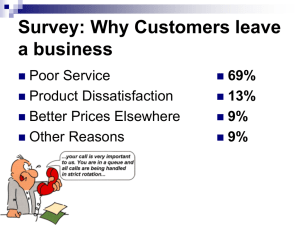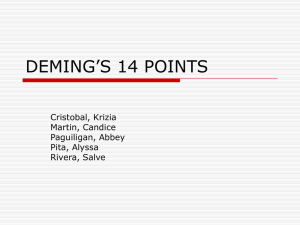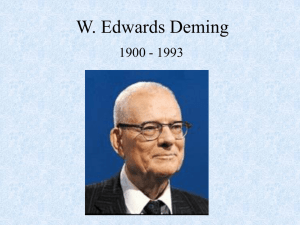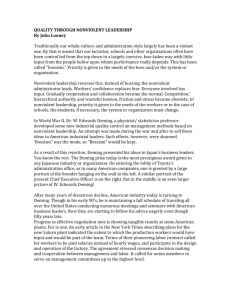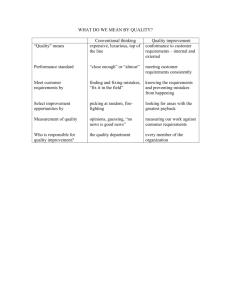108 - NYU Stern School of Business
advertisement
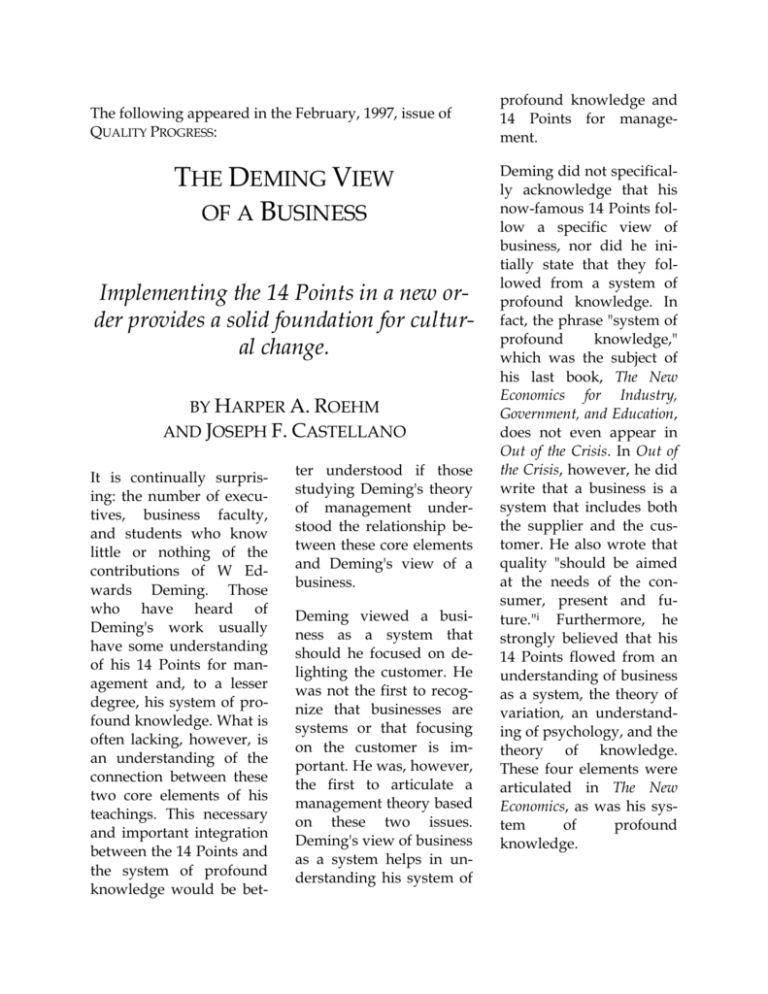
The following appeared in the February, 1997, issue of QUALITY PROGRESS: THE DEMING VIEW OF A BUSINESS Implementing the 14 Points in a new order provides a solid foundation for cultural change. BY HARPER A. ROEHM AND JOSEPH F. CASTELLANO It is continually surprising: the number of executives, business faculty, and students who know little or nothing of the contributions of W Edwards Deming. Those who have heard of Deming's work usually have some understanding of his 14 Points for management and, to a lesser degree, his system of profound knowledge. What is often lacking, however, is an understanding of the connection between these two core elements of his teachings. This necessary and important integration between the 14 Points and the system of profound knowledge would be bet- ter understood if those studying Deming's theory of management understood the relationship between these core elements and Deming's view of a business. Deming viewed a business as a system that should he focused on delighting the customer. He was not the first to recognize that businesses are systems or that focusing on the customer is important. He was, however, the first to articulate a management theory based on these two issues. Deming's view of business as a system helps in understanding his system of profound knowledge and 14 Points for management. Deming did not specifically acknowledge that his now-famous 14 Points follow a specific view of business, nor did he initially state that they followed from a system of profound knowledge. In fact, the phrase "system of profound knowledge," which was the subject of his last book, The New Economics for Industry, Government, and Education, does not even appear in Out of the Crisis. In Out of the Crisis, however, he did write that a business is a system that includes both the supplier and the customer. He also wrote that quality "should be aimed at the needs of the consumer, present and future."i Furthermore, he strongly believed that his 14 Points flowed from an understanding of business as a system, the theory of variation, an understanding of psychology, and the theory of knowledge. These four elements were articulated in The New Economics, as was his system of profound knowledge. Deming's view of a business saw the organization structured as a system whose purpose is to delight the customer. The system of profound knowledge flows from this view of a business, while the 14 Points become a methodology for operationalizing the four elements of profound knowledge. DEMING'S VIEW OF A BUSINESS The first component in Deming's view of a business is the customer. In order to provide quality and delight the customer; it is necessary to know who the customer is and how the customer receives value from the product or service. Management must define the market and the customer being served, and it is responsible for understanding how the organization's product creates value for the customer. Quality can only be defined and understood in the context of the market and a defined customer. timely basis. While a competitive price, reliability, and functionality are required, they are not adequate for a business to remain globally competitive. It must exceed customer expectations. valuable resources. Furthermore, management must provide leadership in a way that fosters value-added continual improvement and innovation in both processes and product. To exceed customer expectations, the business must continually improve both its processes and its product. This continual improvement must add value for the customer. Equally important, the business must also continually innovate both its processes and product in a way that adds value for the customer. Improvement and innovation that do not add value for the customer are a waste of The second component of Deming's view is that a business is a system. Deming viewed the business, customer, and supplier as one system. A system is a group of interrelated processes (process and system are used interchangeably). The greater the degree of interdependency between the components of the system, the greater the need to manage the system. A central theme in Deming's Delighting the customer, in Deming's view, means more than just responding to customer needs, wishes, and expectations on a 2 view of business as a system is the belief that the aim of the system is to optimize the entire system, not its components. Deming also believed that systems have a given capability and that this capability will exhibit variation. For example, assume you are building a bicycle. One of your processes is to cut tubing for the frame, and one of the cut tubings must be 600 millimeters long (or approximately 2 feet). After sampling 50 cut tubings from your process, the average cut is found to be 600.2 millimeters. From this sample you can prepare an X-bar chart of the cuttings. This particular process's capability is represented by the average of 600.2 millimeters; the variation around this average is shown on the chart in Figure 1. Based on the earlier work of Walter A. Shewhart, Deming concluded that processes whose variation fell within three standard deviations of their mean were in control. For the example in Figure I, three standard deviations from the mean has been computed as 604.1 millimeters (upper control limit) and 596.4 millimeters (lower control limit). The term "control limit" means that if an observation falls outside this range, the system is not in control. Since all of the variances in the chart fall within three standard deviations of the mean of 600.2 millimeters, this process is considered under control. Deming went on to conclude that variation within the control limits is considered common-cause variation and is the result of the normal random variation present in all processes. (He often stated in his four-day seminars that 94% of all variation comes from common causes.) Therefore, improvements aimed at reducing common-cause variation can only be achieved by changing the system (for example, buying different raw material or equipment). In contrast, observations falling outside the control limits are considered to be the result of special causes, and immediate corrective action should be implemented (for example, repairing a machine that is out of calibration). Finally, only those systems considered 3 to be under control have a measured capability from which process improvement and innovation can occur. Systems must first be under statistical control before innovation and improvement can be initiated. The components of a system that are responsible for its capability, and hence its results, are people, materials, methods, equipment, and environment. Deming believed that management is solely responsible for each of these components, and because these components determine product quality, management is also responsible for quality. SYSTEM OF PROFOUND KNOWLEDGE Deming's management theory is derived from a natural application of what he called a system of profound knowledge. The elements of profound knowledge are an understanding of a system, variation, psychology, and a theory of knowledge. If one views a business as a system — with a given capability that is subject to variation, it is essential to have an understanding of systems and variation. Furthermore, in a system where people are the most important component and the objective is to delight the customer, a knowledge of psychology is also required. Deming believed that almost every act of management requires prediction, and therefore, an understanding of a theory of knowledge is also necessary. The elements of the system of profound knowledge are interdependent. For example, a study of systems without an understanding of psychology, variation, and a theory of knowledge would be incomplete. The 14 Points for management become the methodology for operationalizing Deming's theory and for creating the environment necessary for a commitment to continual improvement, innovation, and delighting the customer. While Deming never prescribed a process for implementing the 14 Points, the order presented here represents an approach that stresses commitment to employees and provides a foundation for changing a company's culture.ii THE 14 POINTS Point 1: Creating constancy of purpose. Create constancy of purpose for continual improvement of products and services, allocating resources to provide for longrange needs rather than only short-term profitability, with a plan to become competitive, to stay in business, and to provide jobs. Deming believed that for any system to reach its potential and he optimized, it should have a focused purpose. He stated in Point 1 that for businesses to become competitive, stay in business, and provide jobs, they must have a long-term commitment to providing value to their customers. This can only be achieved through continual improvement to processes and products. Constancy of purpose is a recognition that one cannot manage for the short term at the expense of the long term. For example, foregoing preventive maintenance on machines to increase year-end profits will, in the long run, hinder product quality, foster customer dissatisfaction, and be counterproductive to the longterm survival of the business. 4 For all employees to be willing to serve the best interest of the organization — to innovate and improve products and processes and work together for the good of the customer — they must sense a long-term commitment from the organization and know that it is committed to providing a quality product for its customers. Improvement and innovation come primarily from people within the organization. Therefore, employees must know and believe in the aim and purpose of the organization. Likewise, for customers to remain loyal, they also must sense a long-term commitment to their needs. Without constancy of purpose, employees are not sure why the firm is in business or what its aim is. This creates instability, increases variation and fear, and reduces quality. Point 2: Adopting the new philosophy. Adopt the new philosophy We are in a new economic age, created by Japan. We can no longer live with commonly accepted levels of delays, mistakes, defective materials, and defective workmanship. Transformation of Western management style is necessary to halt the continued decline of industry. Point 2 says a transformation is required to adopt the Deming theory of management, and a change in style begins with personal transformation. Deming addressed the need for personal transformation in The New Economics, indicating that the first step is transformation of the individual, and this transformation comes from understanding the system of profound knowledge.iii Deming believed that once an individual understands the system of profound knowledge, he or she will be able to apply its principles in relationships with others and to personal decisions. Such an individual transformation serves as the basis for transforming the organization's culture. A new style of management will emerge, one that recognizes the creative talents of all employees and is committed to the aim of everyone winning over the long term. This new style of management is committed to continually improving the process and focuses all its efforts on delighting the customer. Therefore, adopting the new philosophy operationalizes the commitment to constancy of pur- cannot be transformed without strong leadership. Point 7: Instituting leadership. Adopt and institute leadership aimed at helping people to do a better job. The The PDSA Cycle Explained W. Edwards Deming realized that innovation, improvements to systems, and reducing variation require problem-solving techniques. A key element in this effort is the use of the plan-dostudy-act (PDSA) cycle. The PDSA cycle is a vehicle for constant, continual improvement and innovation, enabling employees to solve problems and be more creative. PDSA involves the following four steps: 1. Plan. A change or improvement is planned. 2. Do. The change or improvement is performed on a small scale. 3. Study. The results of the tested change are studied, and from this study further action is determined. 4. Act, Either continued study is required, the change is implemented, or another change or improvement is initiated. pose. After management has committed to Points 1 and 2, it is ready to lead the transformation. It is management's responsibility to lead the transformation, for a company 5 responsibility of managers and supervisors must be changed from sheer numbers to quality. Improvement of quality will automatically improve productivity. Management must ensure that immediate action is taken on reports of inherited defects, maintenance requirements, poor tools, fuzzy operational definitions, and all conditions detrimental to quality. Because management is responsible for the system and all of its components, it is also responsible for quality. The most important component of a system is people. In order for the system to be optimized, management must recognize that people are not commodities or expenses but the organization's most important asset. Since the components are responsible for the system's output, it is a leader's responsibility to help employees do a better job. A leader must address some basic questions: Are employees properly trained, and do they have the necessary equipment and materials? Has the product and production process been well designed, and is the environment suited for optimum production? A leader's job is not to judge but to provide assistance on a timely basis. A leader must be able to blend the various strengths of individuals to optimize the performance of the system in a way that will exceed customer expectations. Managers who use this approach are often characterized as teachers or coaches, as described by Barry Mass, president of Jamestown Plastics, Jamestown, OH: "For years the foremen were probably 70% hands-on, and now that is going to shift to 30%. We are going to have to become educators. This is something that will be fairly new to us. We are going to have to become teachers and take what we learn and pass it to the people on the floor."iv Management must also understand and monitor processes so that, when problems arise, effective action can be taken. To avoid tampering with processes, management must understand variation and be able to distinguish between commoncause and special-cause variation. When effective corrective action is taken, quality is improved and productivity and cost are automatically improved. Leading the transformation requires management to provide employee training and education. While a change in leadership style is an essential 6 step after implementing Points 1 and 2, employees are often skeptical of changes in leadership style. Employee skepticism can be changed, however, by instituting training in which employees learn to better understand their jobs, systems and variation, and how to institute improvements. Point 6: Instituting training. Institute modern methods of training for everybody's job, including management, to make better use of every employee. New skills are required to keep up with changes in materials, methods, product design, machinery, techniques, and service. Management must provide training so that employees are able to perform the specific tasks of their job, so that they understand processes and variation, and so that they are able to be more creative and solve problems. Diamond-Star Motors, a joint venture between Mazda and Chrysler Corp. in Normal, IL, spent three weeks sharpening employees' creative thinking skills and five weeks on job-specific skills, at a total cost of $13,000 per employee.v If management expects employees to assist in managing the system and to offer solutions to problems and recommend improvements, it must provide training. Deming realized that innovation, improvements to systems, and the reduction of variation requires knowledge of problem-solving techniques, including the plan-do-study-act (PDSA) cycle (for more on this valuable tool, see the sidebar "The PDSA Cycle Explained"). Grand Rapids Spring & Stamping (formerly Grand Rapids Spring & Wire) in Grand Rapids, MI, recognizes the importance of understanding systems and variation and trains its employees in statistical process control. It also spends a great deal of time teaching employees problem-solving techniques, including the PDSA cycle, which they use daily to improve systems and solve problems. As an outgrowth of this training, employees better understand the relationship between their individual jobs and delighting the customer.vi While such training can be extremely effective in yielding process and system improvements, perhaps the greatest benefit is the increase in trust between management and employees. If management trusts employees to make improvements and solve problems without interference, employees in turn believe that management can be trusted. Point 13: Encouraging education. Institute a vigorous program of education, and encourage selfimprovement for everyone. What an organization needs is not just good people; it needs people who are improving with education. Advances in competitive position will have their roots in knowledge. While training is directed specifically at acquiring job skills and process improvement, Deming believed that it is also beneficial for both employees and the organization if employees are continually learning. James Brogden, president and chief executive officer of Master Industries, Ansonia, OH, a longtime believer in Deming's approach, believes that by encouraging education and self7 improvement in all areas of interest, people feel better about themselves and thus become better employees.vii Master Industries has an open education policy that reimburses employees for books and tuition for any course they wish to take, whether or not it is work related. Providing the three levels of training — to perform one's job, to understand processes and variation, and to be more creative and able to solve problems — along with an open education policy, should begin to transform the culture and reduce skepticism. After extensive training, management and employees will better understand systems; variation; and the need to break down barriers, eliminate exhortations, and abolish arbitrary numerical targets. Point 9: Breaking down barriers. Break down barriers between departments and staff areas. People in different areas, such as research, design, sales, administration, and production, must work in teams to tackle problems that may be encountered with product and service. While constancy of purpose, leadership, training, and education can help a company become more responsive and competitive, these initiatives alone are insufficient. Deming observed that many business practices are counterproductive. For example, most organization charts stress departments and specific functional areas and do not seem to recognize that businesses are systems of integrated processes. He found that people often engage in activities that seem in the short run to be beneficial to themselves or their departments — at the expense of the overall business. He believed that this suboptimization can be avoided if people understand that they are a part of an overall system whose survival depends on delighting the customer. Furthermore, the system will function better if functional areas work together — not independent of each other. Deming believed that systems function better when people cooperate rather than compete with each other. He often cited the example of an orchestra: If individual musicians attempt to play their in- struments without regard for the entire group, the orchestra will fail. Rusch O. Dees, vice president of administration at Arkay Plastics, Dayton, OH, described his organization's attempt to break down barriers: "We knocked down the walls, took the offices away from people, took the carpeting away from them, took the couches and lamps away from them, and we put their desks in a T shape with their people. Why? So that if your people talk, you hear them. If you talk, your people hear you."viii Point 10: Eliminating exhortations. Eliminate the use of slogans, posters, and exhortations of the work force, demanding zero defects and new levels of productivity, without providing methods. Such exhortations only create adversarial relationships; the bulk of causes of low quality and low productivity belong to the system, and thus lie beyond the power of the work force. Deming felt strongly that the system and its components (people, materials, methods, equipment, and environment) are responsible for providing quality and delighting the 8 customer. When systems are in a state of statistical control, they have a given capability. This capability can only be improved by changing or improving one or more of the components of the system. Because Deming believed that only management could change the system, he found the use of slogans, arbitrary numerical goals, and quotas to be offensive, ineffective, and harmful. Management's role is not to create slogans, exhortations, and targets, but to work toward an understanding of the system and reducing variation through changes in the system. Slogans, exhortations, and goals for the work force are never a substitute for the training, knowledge, or tools needed to continually improve the process. Point 11: Eliminating arbitrary numerical targets. Eliminate work standards that prescribe quotas for the work force and numerical goals for people in management. Substitute aids and helpful leadership in order to achieve continual improvement of quality and productivity. Point 11 challenges the basic assumptions of traditional management thought. The new philosophy recognizes that goals and numerical quotas are meaningless without a methodology for achieving them. It also recognizes the futility of setting standards or goals without an understanding of the system and the effects of variation. An understanding of variation must lead one to conclude that if the system is stable (i.e., only common-cause variation exists) it is useless to specify numerical quotas or goals, since you will get whatever the system delivers. In short, you can't reach a goal beyond the capability of the system. On the other hand, if the system is not stable (i.e., special-cause variation exists) there is no point in setting a goal since you cannot predict what the system will produce. Real leadership requires an understanding of a system, variation, and how to improve a process. Managing by numbers and objectives will not provide this understanding. Once the system is stable, only management can improve it (i.e., reduce variation). If employees are given quotas and goals with no method or process for achieving results, then fear, poor morale, low self-esteem, and loss of respect and trust will inevitably result. The new paradigm requires focusing on the long run and understanding systems and variation. It requires management to take responsibility for the system rather than blaming employees. It requires leadership, knowledge, and a constancy of purpose directed at neverending improvement of the system. When employees better understand systems, variation, and the need for cooperation, and when barriers, exhortations, and arbitrary numerical goals have been eliminated, employees are prepared for the elimination of merit systems. Point 12: Permitting pride of workmanship. Remove the barriers that rob hourly workers, and people in management, of their right to pride of workmanship. This implies, inter alia, abolition of the annual merit rating (appraisal of performance) and management by objec9 tives. Again, the responsibility of managers, supervisors, and foremen must be changed from sheer numbers to quality. Establishing a constancy of purpose; instituting leadership, training, and education; breaking down barriers; and eliminating exhortations and arbitrary numerical goals do a great deal to build employee trust and empower the work force, but more is required. Deming believed that companies must provide joy in work, and that merit pay systems are the major obstacle to achieving this objective. He gave several reasons for his belief. First, 94% of all variation is the result of common causes. Since this variation occurs randomly it makes no sense to reward or punish workers for what they are not responsible for Second, it is difficult to measure someone's contribution in the short run. In fact, it is difficult to even identify an individual's true contribution without many years of observation. Third, when merit systems are used, employees concentrate on satisfying the short-term criteria of the merit system, not on the long-term goals of the company. Employees should instead be attempting to innovate and improve the system for greater customer satisfaction. Finally, people who operate systems must cooperate to optimize the system and delight the customer. Merit systems encourage competition between workers and are counterproductive to cooperation. They promote self-interest at the expense of the overall system. PQ Systems of Miamisburg, OH, is a good example of a company that eliminated its merit system. It now uses a salary process based on market studies of various job categories and overall company profitability. Employees are involved in the process and in the annual market study updates. Salary increments are not tied to any specific performance measurements, only to market data. The emphasis is on assisting employees so that they can perform their jobs in a way that will delight the customer. Kurt Stueve, general manager, believes that employees receive far more feedback on performance now than when the merit system was used.ix needs only when employees feel free to express themselves and give their opinions. Point 8: Driving out fear. Encourage effective two-way communication and other means to drive out fear throughout the organization so that everybody may work effectively and mare productively for the company. Each of the previous Points is directed at changing a company's culture. A company must first direct its efforts toward developing its own culture before it can be in a position to know what to expect from its suppliers and understand how to assist them. After a company has a stated constancy of purpose, instituted leadership, encouraged training and education, attempted to break down barriers, eliminated exhortations and arbitrary numerical goals, and have fostered pride in workmanship by eliminating the merit system, it will have come a long way toward eliminating fear. In addition, Deming believed that management must encourage two-way communications with employees. It would be extremely difficult, however, to eliminate fear without first implementing all of the Points already discussed. Without these Points in place, the type of management-employee dialogue required would likely be impossible. Management can respond effectively to employees' 10 Point 4: Ending lowesttender contracts. End the practice of awarding business solely on the basis of price tag. Instead, require meaningful measures of quality along with price. Reduce the number of suppliers for the same item by eliminating those that do not qualify with statistical or other evidence of quality. The aim is to minimize total cost, not merely initial cost, by minimizing variation. This may be achievable by moving toward a single supplier for any one item, in a long-term relationship of loyalty and trust. Purchasing managers have a new job, and must learn it. Deming believed that the price paid by the customer at the time of initial purchase does not repre- sent the total cost to the customer. The relevant cost is the total cost of use; therefore he rejected the idea of selecting suppliers and awarding business solely on the basis of purchase price. Furthermore, he believed that to reduce variation and improve quality, companies need to work toward a single supplier relationship for component pants. Multiple suppliers will always create more variation than a single supplier. Deming spoke of a customer-supplier relationship in which the supplier is a part of the system. He concluded that companies must be cautious in their selection of suppliers and only choose those with whom trust has been established and total cost of use is lower. After the company has begun to change its culture, understand systems and variation, and develop stronger and more meaningful relationships with suppliers, it is in a position to cease dependence on mass inspection. Point 3: Ceasing dependence on mass inspection. Eliminate the need for mass inspection as the way of life to achieve quality by building quality into the product in the first place. Require statistical evidence of builtin quality in both manufacturing and purchasing functions. Deming believed that management's efforts should be directed toward improving the system in ways that will delight the customer. If management understands variation and its relationship to systems, there is no need for mass inspection of output. The system needs to be monitored and management must determine when the system is in control. When it is not, management must be capable of distinguishing special-cause variation from commoncause variation. Likewise, companies must assist suppliers in the management of their systems. If the emphasis is on management of systems, companies will not need mass inspection of either their output or their suppliers' output. This does not, however, imply elimination of all inspection — only the need for mass inspection of all output. After the company has started to change its culture, strengthen its rela11 tionships with suppliers, and help employees better understand the system and its purpose, it is more capable of improving every process. Point 5: Improving every process. Improve constantly and forever the system of planning, production, and service, in order to improve every process and activity in the company to improve quality and productivity, and thus to constantly decrease costs. Institute innovation of product, service, and process. It is management's job to work continually on the system (design, incoming supplies, maintenance, improvement of equipment, supervision, training, retraining, and so on). To remain competitive with products and services that will always delight the customer, companies must continually improve their processes and systems. A commitment to continuous improvement begins with knowing what the customer wants and how the product or service will be used. It also requires the recognition that quality begins at the design stage and continues downstream. Continual reduc- tion of waste and improvement of quality in every activity (e.g., purchasing, engineering, production, marketing) must be the focus. A commitment to neverending improvement also involves a recognition that simply allocating more resources will not bring quality. Improved quality must be viewed in the context of process improvement. Such improvements require knowledge about the process and the effects of statistical variation. Point 14: Ensuring top management commitment and action. Clearly define top management's permanent commitment to ever-improving quality and productivity and its obligation to implement these principles. Indeed, it is not enough that top management commit itself for life to quality and productivity. it must know what it is committed to — that is, what it must do. Create a structure in top management that will push every day on the preceding 13 Points, and take action in order to accomplish the transformation. Support is not enough; action is required. Deming was adamant in his belief that top management and the board of directors are responsible for seeing that the system continues to produce a product that delights the customer In short, leaders must lead. Top management's role is to take responsibility for problems and mistakes and lead the organization in changing the system. In the final analysis, what the transformation really involves is management's willingness to give up the old paradigms of management control (e.g., management by objectives, management by the numbers, and merit systems). It must be willing to replace competition with cooperation. It must be willing to admit that an organization can be built on the empowerment of people and not on the basis of rewards and punishment. It must be ready to encourage innovation and risk taking, even though failures will occur. Only then can the organization begin its transformation. LEVELS OF COMMITMENT TO EMPLOYEES Much of what Deming wrote pertained to management's commitment to employees. He was appalled that many managers treated employees as expendable costs rather than their most valuable resource. While he did not include a 15th Point called "levels of commitment," his 14 Points define levels of management commitment to employees that must be present to support a culture of continuous improvement. And while Deming never suggested an order of implementation for his 14 Points, the order specified here may help in creating that culture. It represents a strong commitment to employees and provides a solid foundation for change. Harper A. Roehm is a professor of accounting at the University of Dayton in Ohio. He has a doctorate in accounting from Florida State University in Tallahassee. Roehm is a member of ASQC. Joseph F. Castellano is a professor of accounting at Wright State University in Dayton, OH. He has a 12 doctorate in business administration from St. Louis University in Missouri. Castellano is a member of ASQC. References W. Edwards Deming, Out of the Crisis. (Cambridge. MA: Massachusetts Institute of Technology, Center for Advanced Engineering Study, 1986), pp.4-5. ii The wording for each of the 14 Points has been taken from Henry R. Neave, The Deming Dimension (Knoxville, TN: SPC Press, 1990), pp.287-405. iii W. Edwards Deming, The New Economics for Industry, Government, and Education (Cambridge, MA: Massachusetts Institute of Technology, Center for Advanced Engineering Study, 1993). pp.94-95. iv H. A. Roehm, T. Hayes, and J. F. Castellano, "Quality Addiction: True Confessions," Organization Development Journal, Fall 1993, p.80. v William I. Hampton, "How Does Japan Inc. Pick Its American Workers'?" Business Week, Oct. 3, 1988, p.84. vi R. A. Roehm, D. Klein, and J. F. Castellano, "Springing to World Class Manufacturing," Management Accounting, March 1991, pp. 40-44. vii Roehm, Hayes, and Castellano, "Quality Addiction: True Confessions;' p. 73. viii Ibid., p. 77. ix Kurt Stueve, lecture given at University of Dayton, Dayton, OH, spring 1995. i 13
